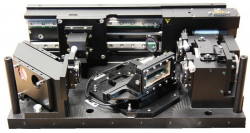
-
StatusCompleted
-
Status date2019-01-10
-
Activity Code5C.162
The objectives of this project were to build up a breadboard of an optical beam delay system (BDS) compatible to the existing OGS on Tenerife and to investigate the inconsistencies of multi aperture up-link technique to ARTEMIS satellite seen in the past. Therefore a test campaign with several successful up-links was done after completion and integration of the BDS hardware. Main test objective was to evaluate if the multi-aperture fade mitigation technique in combination with different delay length (to get the individual beams temporally incoherent) is valid. Beside this additional test have been performed. Amongst others measurements of the tilt fluctuation, the Fried parameter r0 and scintillation effects.

The key issue of this project was the investigation of the inconsistencies of multi aperture up-link technique to ARTEMIS satellite seen in the past.
Key issues with regard to the test results were the evaluation if the multi-aperture fade mitigation technique in combination with different delay lengths, to get the individual beams temporally incoherent, is valid.
- Update of optical bench of the OGS on Tenerife
- More detailed understanding of up-link technique to ARTEMIS satellite
- Investigation of the inconsistencies of multi aperture up-link technique seen in the past.
- New findings regarding multi-aperture fade mitigation technique in combination with different delay length to get the individual beams temporally incoherent.
- Measurement of tilt fluctuations (from the fine tracking system of OGS)
- Measurement of fried parameter r0 (focus camera)
- Measurement of scintillation (from the fine tracking system of OGS)
The BDS is an optical delay system with two operational modes. The first one is a non-splitting mode where an entrance beam goes as single beam through the system. Incoming and outgoing beam have the same intensity but the polarisation is rotated from vertical to horizontal. The second is a splitting mode where an entrance beam is split into two single beams with an intensity of 50% each. Furthermore these two beams can temporary be shifted to each other by an optical delay line. This comprises two parts. First a static delay of beam 1 to compensate the lateral beam offset and to ensure a delay of 0 ns. Second a moveable delay line into beam 2 to increase the delay between both beams up to 1ns (equal to 300 mm optical length). This adjustment from 0 to 300 mm is realized by a beam reflectance element and a motorized rail stage with encoder for calculating the delay length. This enables the user to select an operational mode and change delay length without opening the device and losing the link to Artemis. Both channels are designed to ensure the correct polarisation for the subsequent optical system and withstand the input laser power of 10W @ 847nm.
For operation a Controller Unit was built up which includes the supply and communication interface of the three electric moveable stages inside the BDS. To calibrate the pointing of the two outputs continuously during operation an additional measurement system consisting of a collimator and attenuators was integrated to the optical bench.
To get meaningful test results over the different up-links the main requirement for the test campaign as well as the design of the BDS was to ensure a pointing stability and parallelism accuracy of both beams to each other within 1 arcsec during operation.
The development, integration and implementation of the Beam Delay System were accomplished in September 2012. Within the measurement campaigns in October 2012 and in April 2013 at OGS on Tenerife a successful characterization of the uplink and downlink from the ARTEMIS satellite was done. Subsequent analysis of the test results show that the objectives of the project have been reached.
The current status of the project can be stated with successfully finished.




